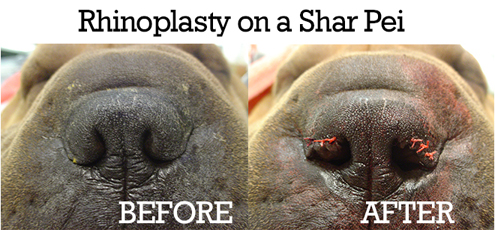
Dr. Phil Zeltzman is a mobile, board-certified surgeon in Allentown, PA and the co-author of “Walk a Hound, Lose a Pound." Find him at www.DrPhilZeltzman.com.
Cosmetic or plastic surgery is a hot topic. Is it medically acceptable to implant fake silicone testicles in a dog? Is it ethical to debark, or crop ears, or cut off a tail?
Plastic surgery is meant “to enhance appearance through surgical and medical techniques.” Other procedures may be considered cosmetic, but they are really meant to fix medical issues. Here are five medically-indicated examples.
Rhinoplasty, or the "Nose Job"
Many dogs with a “flat face”, called brachycephalic breeds, have tiny nostrils. So small, that they can barely breathe through their nose, and they often have to pant in order to get enough oxygen on board. This makes this condition extremely stressful. At worst, some patients suffocate, “turn blue” as we say, and pass out. Common dog breeds include Bulldogs, Boston terriers, pugs and Pekingeses. Some cat breeds can be affected as well: Himalayans and Persians are brachycephalic breeds as well.
Narrow nostrils can lead to other problems: the soft palate, in the back of the throat, can become too long, or “elongated”, and causes the pet to snore. Treatment involves surgery to trim the soft palate. Also, the saccules, two small fleshy pieces of tissue in the larynx or voice box, can get enlarged, stick out and decrease air flow. They are called “everted laryngeal saccules.” They also can be removed surgically.
But back to our nose job. If the nostrils are too narrow, a common procedure, called a “rhinoplasty”, can be done to enlarge them. A wedge of an appropriate size and shape is removed. A few small stitches are placed.
Research suggests that doing a rhinoplasty early in life, as young as 3 months of age, may prevent further problems with the soft palate and the saccules. Unfortunately, few pet owners know this... This simple procedure may save the pet from suffocating and more surgery later in life. Incidentally, this is also a big money saver.
Therefore, a rhinoplasty can be a preventive surgery early on or a big help later in life. Either way, it can make a dramatic difference in the pet’s quality of life.

Nasal Fold Surgery
Still in the nose department, brachycephalic dogs and cats can have a skin fold across their nose. This can cause 2 sets of problems: skin irritation or infection, and eye problems. The hair on the skin fold can rub against the eye, causing all sorts of problems and pain. The treatment consists of removing just enough skin to address both issues.
Cheiloplasty, or Lip Tuck
“Dogs drool. Cats rule.”
Sure, some dogs drool excessively, to the point that every head shaking session can send strands of slobber across a room or all over the walls. It takes a very special owner to live with that…
Excessive drooling can cause severe irritation or infection of the skin. The “lip tuck” or cheiloplasty is designed to decrease drooling, usually in large dog breeds. The procedure entails stitching the lower lip to the upper lip to create a “dam” that helps the dog swallow his own saliva, rather than drooling. It is not 100% perfect, but it can help significantly.
Eyelid Surgery
No, we are still not talking about California-style make-overs. Cats and dogs can have an eyelid that rolls in (entropion) or out (ectropion).
With entropion, the eyelids roll inward and the eyelashes rub against the eye, causing irritation and pain. This can be seen in Shar Peis, Chow Chows, Bulldogs, Retrievers, Rotties, Setters etc.
With ectropion, the edge of the eyelid rolls out. Its lining, or conjunctiva, appears red. Constant exposure causes irritation (conjunctivitis) or infection. Common breeds include Bloodhounds, Mastiffs, Great Danes, Newfies, St. Bernards etc.
In either case, just enough skin needs to be removed to correct the problem. Because these conditions are considered inheritable, affected pets should be neutered to avoid spreading the bad genes.
As you can see, “cosmetic” surgery may be medically recommended to actually address a medical condition. If you feel that your pet would benefit from one of these procedures, you may want to ask your family veterinarian.
If you have any questions or concerns, you should always visit or call your veterinarian – they are your best resource to ensure the health and well-being of your pets.
The opinions and views expressed in this post are those of the author's and do not necessarily represent the beliefs, policies or positions of PetHealthNetwork.com, IDEXX Laboratories, Inc. or its affiliates and partner companies.
